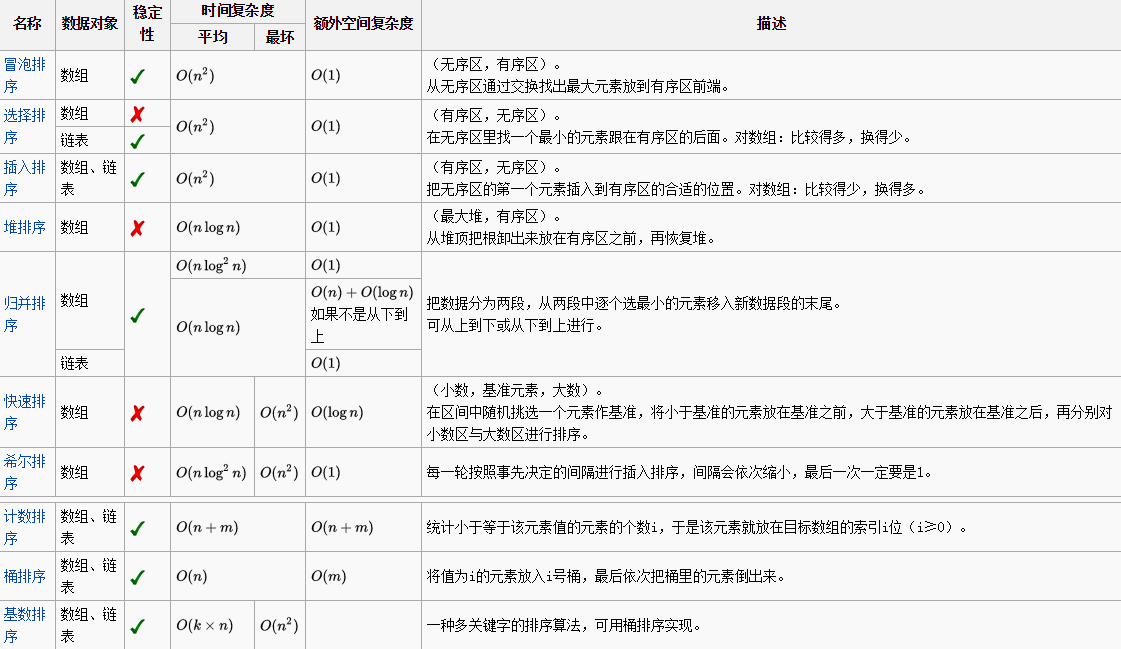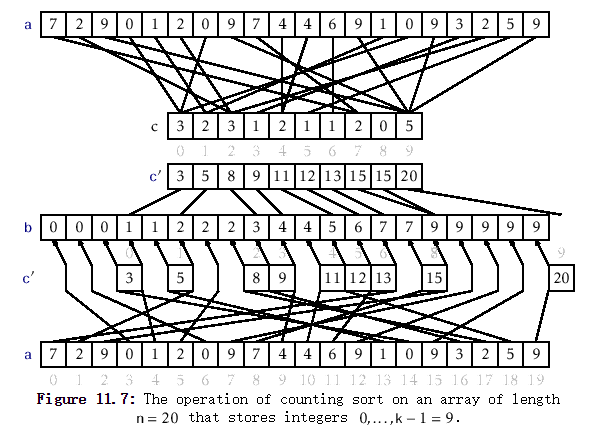@Sakura-W
2016-09-02T08:28:18.000000Z
字数 8481
阅读 1405
排序算法
数据结构与算法
一、概述
1.时间复杂度:
一般而言,对于一个排序,比较好的性能是O(NlogN),坏的性能是O(n^2),最理想的性能是O(n)。仅使用一个抽象关键比较运算的排序算法总平均上至少需要O(NlogN)。
2.稳定性:
稳定排序算法会让原本有相等键值的记录维持相对次序。也就是说,如果一个排序算法是稳定的,当有两个相等键值的记录和R和S,且在原本的列表中R出现在S之前,在排序过后的列表中R依然在S前面。
3.分类:
1)根据排序的数据是否全部在内存中:内部排序和外部排序。
2)根据排序方法的稳定性:稳定排序和不稳定排序
3)根据排序的方法:插入(插入排序、希尔排序)、选择(选择排序、堆排序)、交换(冒泡排序、快速排序)、合并(归并排序)等
4.内排序算法分类:
1)简单排序算法,时间复杂度为O(n^2):冒泡排序、插入排序和简单选择排序。性能比较:直接插入排序 > 简单选择排序 > 冒泡排序
2)改进算法,时间复杂度为O(nlogn):堆排序、希尔排序、归并排序和快速排序
3)非基于比较的算法,时间复杂度为O(n):计数排序、桶式排序和基数排序

二、内排序
1.冒泡排序
1)说明:对当前还未排好序的数,自上而下对相邻两个数依次比较和调整,让较大的数往下沉,较小的数往上冒(故称为冒泡)。
2)实现:
public static void bubbleSort(int[] a){int temp;//中间数for(int i = 0; i < a.length - 1; i++){//i表示交换的次数,总共交换a.length - 1次就足够了for(int j = 0; j < a.length - 1 - i; j++){if(a[j] > a[j+1]){//相邻两数交换,使得最大值往最后走temp = a[j];a[j] = a[j+1];a[j+1] = temp;}}}}
3)改进:设置标记,如果某趟排序过程中未发生任何交换,说明数据已经是有序的了,就不用再进行排序了
public static void bubbleSort(int[] a){boolean flag = true;//设置标记int temp;for(int i = 0; i < a.length - 1 && flag; i++){flag = false;for(int j = 0; j < a.length - 1 - i; j++){if(a[j] > a[j+1]){temp = a[j];a[j] = a[j+1];a[j+1] = temp;flag = true;}}}}
2.简单选择排序
1)说明:选择排序的基本思想是每一趟在n-i+1个记录中选择关键字最小的记录作为序列的第i个记录。
简单选择排序比较的次数比较多,但移动数据的次数比较少,性能优于冒泡排序
2)实现:
public static void selectSort(int[] a){int min, temp;//min表示最小记录的位置,temp为了暂存值for(int i = 0; i < a.length; i++){min = i;for(int j = i + 1; j < a.length; j++){if(a[min] > a[j]){min = j;}}if(min != i){temp = a[min];a[min] = a[i];a[i] = temp;}}}
3.直接插入排序
1)说明:基本操作是将一个记录插入到已经排好序的有序表中,从而得到一个新的、记录数加1的有序表。性能优于冒泡排序和简单选择排序。
2)实现:
public static void insertSort(int[] a){int temp, i, j;for(i = 1; i < a.length; i++){if(a[i] < a[i - 1]){//说明顺序不对,需要排序temp = a[i];for(j = i - 1; j >= 0 && a[j] > temp; j--){a[j + 1] = a[j];//逐个往后腾出位置}a[j+1] = temp;}}}
4.希尔排序
1)说明:也是利用插入进行排序,与直接插入排序不同的是:将关键字较小的记录跳跃式地往前移动,从而使得每次完成一轮循环后,整个序列就变得有序一些。希尔排序的关键并不是随便分组后各自排序,而是将相隔某个增量的记录组成一个子序列,实现跳跃式的移动,使得时间复杂度小于O(n^2)
2)实现:
public static void shellSort(int[] a){int i, j, temp;int increment = a.length;do{increment = increment/3 + 1;//确定增量的大小for(i = increment; i < a.length; i++){if(a[i] < a[i - increment]){//这部分与插入排序的思想一致,只是插入排序的增量总是1temp = a[i];for(j = i - increment; j >= 0 && temp < a[j]; j -= increment){a[j+increment] = a[j];}a[j+increment] = temp;}}}while(increment > 1);}
5.堆排序
1)说明:堆是一种完全二叉树,其根结点一定是堆中所有结点最大值或者最小值。堆排序就是利用堆进行排序的方法,其基本思想是:将待排序的序列构造成一个大顶堆,此时整个序列的最大值就是堆顶的根结点,将它移走(与末尾元素交换,此时末尾元素就是最大值了),然后将剩余的n-1个元素重新构造成一个堆,如此循环下去,便能得到一个有序序列了。
2)实现:
public class HeapSort {private static int[] sort = new int[]{1,0,10,20,3,5,6,4,9,8,12,17,34,11};public static void main(String[] args){System.out.println("Before Build: " + Arrays.toString(sort));buildMaxHeap(sort, sort.length);System.out.println("After Build: " + Arrays.toString(sort));heapSort(sort, sort.length);System.out.println("After Sort: " + Arrays.toString(sort));}public static void heapSort(int[] arr, int size){//构建最大堆buildMaxHeap(arr, size);//交换元素for(int i = size - 1; i > 0; i--){//将堆顶元素与数组最后一个元素交换swap(arr, 0, i);//重新构建大顶堆buildMaxHeap(arr, i);//这里不能是i - 1,与buildMaxHeap有关}}/*** 创建最大堆* @param arr* @param size*/public static void buildMaxHeap(int[] arr, int size){for(int i = size / 2; i >= 0; i--){maxHeapify(arr, size, i);}}/*** 调整无序区(使其部分成为二叉堆)* @param arr* @param size* @param index*/public static void maxHeapify(int[] arr, int size, int index){int leftSonIndex = 2*index + 1;int rightSonIndex = 2*index + 2;int temp = index;if(index <= size / 2){if(leftSonIndex < size && arr[temp] < arr[leftSonIndex]){temp = leftSonIndex;}if(rightSonIndex < size && arr[temp] < arr[rightSonIndex]){temp = rightSonIndex;}if(temp != index){swap(arr, index, temp);maxHeapify(arr, size, temp);}}}/*** 交换数组中两数的值* @param arr* @param i* @param j*/public static void swap(int[] arr, int i, int j){int temp = arr[i];arr[i] = arr[j];arr[j] = temp;}}
3)评价:运行时间主要是消耗在初始构建堆和重建堆时的反复筛选上。时间复杂度为O(nlogn)。不适用于排序序列个数较少的情况
6.归并排序
1)说明:归并是指将两个或两个以上的有序表组合成一个有序表。归并排序利用归并的思想将无序序列中的元素两两排序后再合并,最终获得一个有序序列。归并排序利用了分治算法的思想。
2)实现:
public class MergeSort {public static void main(String[] args) {int[] arr = {26, 5, 98, 108, 28, 99, 34, 56, 64, 1};mergeSort(arr);//打印排序好的数组for (int i : arr) {System.out.print(i + " ");}}/*** 对外接口:最终的排序方法* @param a*/public static void mergeSort(int[] a){System.out.println("开始排序");sort(a, 0, a.length - 1);}/*** 递归地将数组分成小的片段* @param a* @param left* @param right*/private static void sort(int[] a, int left, int right){if(left >= right){return;}int mid = (left + right) / 2;sort(a , left, mid);sort(a, mid + 1, right);merge(a, left, mid, right);}/*** 合并两个已经排序好的序列* @param a* @param left* @param mid* @param right*/private static void merge(int[] a, int left, int mid, int right){//中间数组int[] temp = new int[a.length];int r1 = mid + 1;int tIndex = left;int cIndex = left;//把数组中一部分数据排序好while(left <= mid && r1 <= right){if(a[left] <= a[r1]){temp[tIndex] = a[left];tIndex++;left++;}else{temp[tIndex] = a[r1];tIndex++;r1++;}}//把左边或者右边还剩下的数据拷贝到新的数组中while(left <= mid){temp[tIndex] = a[left];tIndex++;left++;}while(r1 <= right){temp[tIndex] = a[r1];tIndex++;r1++;}//将排序好的数组拷贝到原来的数组while(cIndex <= right){a[cIndex] = temp[cIndex];cIndex++;}}}
3)评价:归并排序是一种比较占用内存,但效率高且稳定的算法。其时间复杂度为O(nlogn),空间复杂度为O(n + logn)
7.快速排序
1)说明:通过一趟排序将待排序记录分割成独立的两部分,其中一部分记录的关键字均比另一部分的记录的关键字小,则可分别对这两部分记录继续进行排序,以达到整体有序的目的。
2)实现:
public class QuickSort {public static void main(String[] args) {int[] arr = {55, 5, 98, 108, 28, 99, 34, 56, 64, 1};qSort(arr, 0, 9);for (int i : arr) {System.out.print(i + " ");}}/*** 对外接口* @param arr*/public static void quickSort(int[] arr){qSort(arr, 0, arr.length - 1);}/*** 分治、递归地对数组进行处理* @param arr* @param low* @param high*/private static void qSort(int[] arr, int low, int high){if(low < high){//确定基准值int pivot = partition(arr, low, high);//递归排序左右数组qSort(arr, low, pivot - 1);qSort(arr, pivot + 1, high);}}/*** 依据基准值给数组大致划分为两部分,左边的数都小于基准值,右边的数都大于基准值* @param arr* @param low* @param high* @return*/private static int partition(int[] arr, int low, int high){//把数组的第一个数当做基准值int pivot = arr[low];//将数组中大于和小于等于基准值的数据分开while(low < high){//从数组右侧开始,如果某数大于基准值,则high减小一位,如果数组小于或等于基准值,则跳过该步骤while(low < high && arr[high] > pivot){high--;}//如果数组右侧某值小于基准值,则将数值的值赋值给左侧相应位置if(low < high){arr[low] = arr[high];low++;}//从数组左侧开始,如果某数小于基准值,则low增加一位,如果大于基准值,则跳过该步骤while(low < high && arr[low] <= pivot){low++;}//如果数组右侧某值大于基准值,则将数值的值赋值给右侧相应位置if(low < high){arr[high] = arr[low];high--;}}//扫描完成,基准值到位arr[low] = pivot;//返回基准值的位置return low;}}
8.计数排序
1)说明:计数排序使用一个额外的数组C,其中第i个元素的值是待排序数组A中值等于i的元素的个数。然后根据数组C来将A中的元素排到正确的位置。

2)实现:
public static int[] countSort(int[] a, int k) {//k表示数组中最大值max+1//创建辅助数组int c[] = new int[k];//c[i]表示i的个数for (int i = 0; i < a.length; i++){c[a[i]]++;}//c[i]表示i的位置(从后面开始数,第一个i的位置)for (int i = 1; i < k; i++){c[i] += c[i-1];}//创建输出数组int b[] = new int[a.length];//扫描原始数组a,并将a[i]放到相应的位置for (int i = a.length-1; i >= 0; i--){//c[a[i]]表示从右边开始,a[i]所处的第一个位置,每次赋值后,c[a[i]]要减一b[--c[a[i]]] = a[i];}return b;}
改进:
public static int[] countSort(int[] a){//最后排序后返回的数组int[] b = new int[a.length];//确定待排序的数组中的最大值和最小值,确定中间数组C的大小int max = a[0];int min = a[0];for (int i : a) {if(i > max){max = i;}else if(i < min){min = i;}}//创建中间数组的大小int k = max - min + 1;int[] c = new int[k];//确定C数组中某个位置的值的大小for(int i = 0; i < a.length; i++){c[a[i] - min] += 1;//改进的地方,不用创建很大的中间数组了}//确定C中某项的值(包括小于和等于其小标的所有值)for(int i = 1; i < c.length; i++){c[i] = c[i] + c[i - 1];}//按存取方式取出c中的元素,放入b数组中for(int i = a.length - 1; i >= 0; i--){b[--c[a[i] - min]] = a[i];}return b;}
3)评价:计数排序是用来排序0到100之间的数字的最好的算法,但它不适合按字母顺序排序人名。计数排序对于数据范围很大的数组,需要大量时间和内存,并不适用。
9.桶式排序
1)说明:扫描序列A,根据每个元素的值所在的区间,放入指定的桶中(顺序放置),然后对每个桶中的元素进行排序(什么排序算法都可以,比如插入排序),最后依次收集每个桶中的元素,顺序放置到输出序列中。
2)实现:
public static void bucketSort(int[] arr){//确定数组中最大值和最小值int max = arr[0];int min = arr[0];for(int i = 0; i < arr.length; i++){if(max < arr[i]){max = arr[i];}else if(min > arr[i]){min = arr[i];}}//初始化桶(这里简单地用二维数组表示桶的集合,每个一维数组表示一个桶,实际上应该用链表来表示桶,因为元素的个数并不确定)int bucketCount = (max - min) / arr.length + 1;int[][] buckets = new int[bucketCount][arr.length];//每个桶的当前存储位置int[] order = new int[bucketCount];//把原始数组中的元素分配到各个桶中for(int i = 0; i < arr.length; i++){//k表示该数被分配到第几个桶int k = arr[i] / arr.length;buckets[k][order[k]] = arr[i];order[k]++;}//将各个桶中的数据排序for(int i = 0; i < bucketCount; i++){Arrays.sort(buckets[i]);}//按顺序,将一个一个桶中的元素打印出来for(int i = 0; i < bucketCount; i++){for(int j = 0; j < buckets[i].length; j++){if(buckets[i][j] != 0){System.out.print(buckets[i][j] + " ");}}}}
这个实现方法采用数组来表示桶,并不是太合适,最好能够使用一个链表表示一个桶,这样比较灵活。这个方法采用Java的Arrays类的静态搜索方法Arrays.sort()来对每个桶中的序列排序,主要为了方便.
10.基数排序
1)说明:桶排序都只是在研究一个关键字的排序,而基数排序能够对多个关键字进行排序。基数排序分为:MSD排序和LSD排序。MSD排序:先以主关键字排序,将序列分成主关键字相同的若干堆,再按照次关键字对每一堆单独排序;LSD排序:首先按照次关键字排序,然后按照首要关键字排序,要求是排序的算法必须是稳定的,否则会取消前一次排序的结果。
2)实现:
public static void radixSort(int[] arr, int d){int n = 1;//表示位数,开始的时候是个位int k = 0;//下标,用于保存每一位的排序结果,用于下一位排序的输入//创建桶int[][] buckets = new int[10][arr.length];//创order数组表示当前桶的位置int[] order = new int[arr.length];while(n < d){//将待排序列分配到各个桶里for (int num : arr) {//表示该数应该存在第几个桶中int digit = (num / n) % 10;//order[digit]初始值为0buckets[digit][order[digit]] = num;order[digit]++;}//按顺序将桶中的序列赋值到原数组for(int i = 0; i < arr.length; i++){if(order[i] != 0){for(int j = 0; j < order[i]; j++){arr[k] = buckets[i][j];k++;}}//还原,便于下一次排序order[i] = 0;}//还原,便于下一次排序n *= 10;k = 0;}}
3)评价:计数排序、桶式排序和基数排序都是非基于比较的排序算法,而其时间复杂度依赖于数据的范围,桶排序还依赖空间的开销和数据的分布。基数排序是一种对多元组排序的有效方法,具体实现要用到计数排序或桶排序。
